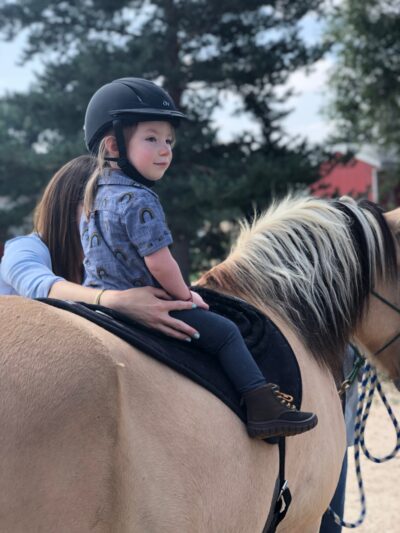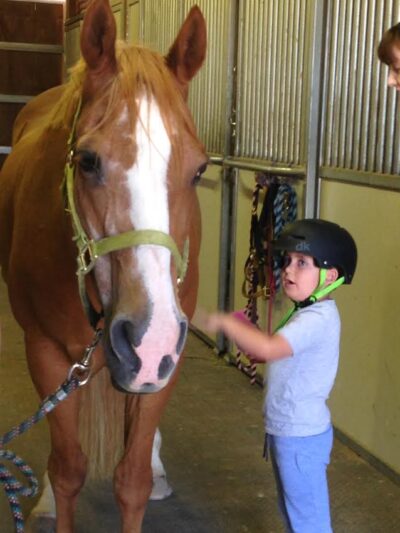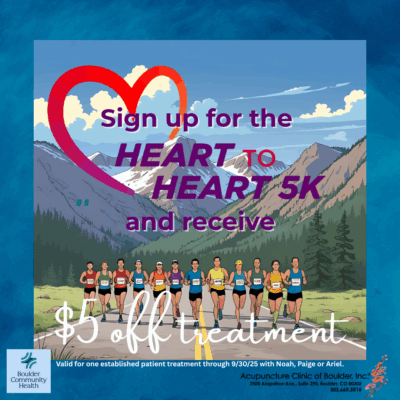
Cathy Lauderbaugh, M.A., CCC-SLP
This article discusses equine movement as a treatment tool for speech therapy and communication-related learning. The movement of the horse is unique since it provides sensory input that is multi-dimensional, consistent, predictable, and highly organized. The therapist can manipulate the horse’s movement to support the many factors contributing to speech and language learning.1 Family coaching is an additional critical component of effective therapy; research shows learning is more effective when therapy supports family dynamics and family routines. Below are some examples of why equine movement is beneficial.
Holistic System Organization:
A positive change in one subsystem of the body will positively influence another subsystem within the body (Dynamic Systems Theory). These changes promote self-organization within the organism; in other words, the more organized the entire child is, the more effective their learning will be.1 For example, a child with a “slumped” posture may also have difficulties with breath support and visual scanning, as secondary impacts from limited postural alignment. Skilled equine movement during a learning opportunity positively impacts postural alignment, which allows the child to increase the range of their visual field, as well as have increased capacity of their breath support system.2

Core Integration and Engagement:
A person’s core unit can be explained through the “pressure canister” model where the bottom of the core is the pelvic floor, the middle is the diaphragm, the top is the vocal folds, the front is the Transversus Abdominus, and the back is the multifidus. While this model is simplified, it is an excellent way to visualize the main parts of the core. The movement of the horse directly influences the pelvic floor of the person on the horse’s back; the therapist can then modify the movement to support changes in core engagement and postural alignment.3 These changes can then be used to support increased system arousal and attention for learning. Additionally, open mouth posture can be reduced by developing resting mouth posture and nasal breathing as part of appropriate postural alignment. This area can impact speech intelligibility and rate of speech.1,2
Purposeful Movement and Sensory Processing:
Purposeful movement activates the cerebellum in the brain. The cerebellum is responsible for coordinating movement, balance and posture, and supports primary functions of communication including speech sound production, lexical choice, and verbal learning and memory.1
The movement of the horse is unique since it emphasizes kinesthesia through side-side (lateral) input and simultaneous vertical displacement.1 Manipulation of these inputs together, especially vestibular inputs, supports language processing through quicker responses that are more organized.1, 5
The sensory input of the horse is regulating, organizing, and supports attention and motivation. Different positions on the horse and changes in the horse’s movement can be used to integrate sensory reflexes associated with different language learning skills.1, 2

The Theory of Entrainment:
A great example of entrainment is when two runners fall into step with one another.2 The therapist can use this concept to help the child entrain to the rhythm of the horse. Equine movement is consistent and predictable so the therapist can purposefully change it to produce a change in the child’s speech or language processing.1 A therapist might stop the equine movement in order to emphasize wait-time for language processing or “move your mouth with mine” strategies. Rate of speech can be slowed down or quickened; the equine movement provides rhythmic input for timing of breath.1, 2
Generalizing Equine Movement to Daily Routines:
While we cannot replicate equine movement perfectly, we can use other types of purposeful movement to optimize learning opportunities off the horse. Generalization is extremely important since we do not have a horse in our daily routines! Some examples that support learning through movement and play: stomping out words, bouncing on a ball or swinging (e.g. providing vestibular input or vertical displacement, e.g. the therapist can pause the movement on purpose). Movement activities, such as slides, swings, and scavenger hunts, also create regulation and motivation.2
What About Equine-Assisted Environments?
An equine-assisted environment refers to when a child does not get on the horse, but instead interacts with the horse in natural, outdoor settings. Horses are extremely social animals, and the therapist can facilitate interactions with peers and horses to support social communication learning. Our Collaborative Learning with Ponies Groups include about 8-9 children and support problem-solving, perspective taking, and self-advocacy through interactions with horses.2 These groups follow best practice for learning: movement, the outdoors, and thinking within a group.4

Final Thoughts:
This article is a very brief overview of the benefits of equine movement as a treatment tool, as well as a general movement-based approach. There are many ways to individualize these tools for the different needs of individual children and families.2 Family coaching is an additional critical component of effective therapy; research shows learning is more effective when therapy supports family dynamics and family routines.5
About Cathy and Creative Strategies Therapy:
Our team is passionate about using movement and play to support learning; we emphasize the importance of family coaching and enjoy forming genuine relationships with our families. Our specialties include: articulation, phonological processing disorders, childhood apraxia of speech, oral-motor skills, tongue thrust/lisp, fluency/stuttering, language processing, and social language. We also specialize in feeding therapy and incorporate movement-based learning principles into our “food school” and feeding therapy sessions.
Connect with Cathy and the Creative Strategies team at www.CreativeStrategiesTherapy.com
Footnote Citations:
To ensure credit is given to the many people who have supported my learning, I have used footnotes throughout the article to cite sentences, concepts, and sections. This article cannot begin to account for all the many people who have contributed to the “movement-based learning” literature and evidence-base; I have chosen a very small subset of research to highlight work that specifically relates to equine movement as a treatment tool.
1- American Hippotherapy Association (2024). Hippotherapy Treatment Principles Part II: Clinical Problem Solving Manual. 5th edition.
The American Hippotherapy Association’s Level I and Level II Manuals contain a substantial list of research pertaining to specific topics; these manuals summarize and compile the vast amount of research related to Sensory Integration, Entrainment and Rhythmicity, System Arousal, Postural Control and Balance, Dynamic Systems Theory, Motor learning, and Neuroplasticity, and other related topics pertaining to equine movement as a treatment tool.
2- Case Studies and Clinical Experience examples from my work as an SLP (Cathy Lauderbaugh).
3- Massery, Mary, PT, DPT, DSc. Linked: Breathing and Postural Control. Interactive Online Course sponsored by the American Hippotherapy Association. 3/17/2021-3/19/2021.
4- Paul, A. M. (2021). The extended mind: the power of thinking outside the brain. Boston, Houghton Mifflin Harcourt.
5- Vestibular Processing and Language Processing Research examples:
Bigelow, R.T. and Agwal, Y., Vestibular involvement in cognition: visuospatial ability, attention, executive function, and memory, J. Vestibular Res., 2015, vol. 25, no. 2, p. 73.
Efimova, V.L., Nikolaeva, E.I. The Role of the Vestibular System in the Development of
Specific Language Disorders in Children. Hum Physiol 46, 306–311 (2020). https://doi.org/10.1134/S0362119720030032
5- Examples of Research pertaining to the importance of Family Coaching:
Carnes, B.M. (2012). “Benefits of Early Intervention and Family-Centered Practices for Children with Communication Disorders.” Research Papers. Paper 262.
Dempsey, I. & Dunst, C. (Sept 2007). Family-Professional Partnerships and Parenting Competence, Confidence, and Enjoyment. International Journal of Disability Development and Education 54(3): 305-318.
McWilliam, R.A. (2010). Working with Families of Young Children with Special Needs. New York: Guilford.
Rush, Sheldon, Hanft (Jan 2003). Coaching Families and Colleagues: A Process for Collaboration in Natural Settings. Infants and Young Children 16(1): 33-47.



